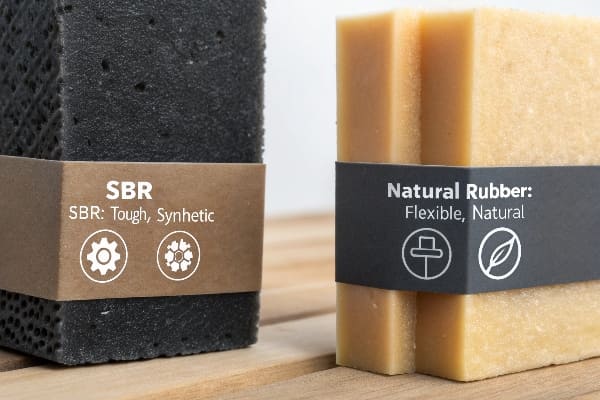Styrene-butadiene rubber1 (SBR) and natural rubber are both widely used in various industries, but they have distinct properties that make each more suitable for specific applications. Understanding their differences can help in selecting the right material for your needs.
SBR and natural rubber2 differ significantly in terms of origin, performance characteristics, and suitability for various applications. Each material has its strengths depending on the use case.

Let’s dive deeper into the properties, performance, and typical uses of both materials to better understand how they compare.
What is SBR (Styrene-Butadiene Rubber)?
SBR is a synthetic rubber made by polymerizing styrene and butadiene. It is commonly used in tire manufacturing and other applications that require good wear resistance3, abrasion resistance, and low-cost production. SBR has excellent processability and is relatively easy to mold, making it popular in various industrial products.
SBR is a versatile synthetic rubber with excellent wear and abrasion resistance, making it perfect for tires and general-purpose applications.
SBR is produced in large quantities and is a cost-effective alternative to natural rubber in many applications. While it offers good wear and aging resistance, its overall elasticity and strength are typically lower than those of natural rubber. SBR is ideal for tire treads, footwear, gaskets, seals, and various industrial products that need to withstand normal wear but don’t face extreme conditions like exposure to oils or chemicals.
Properties of SBR
| Property | SBR (Styrene-Butadiene Rubber) |
|---|---|
| Origin | Synthetic (made from styrene and butadiene) |
| Wear Resistance | Good |
| Abrasion Resistance | High |
| Oil & Chemical Resistance | Poor |
| Temperature Resistance (°C) | -30 to 100 |
| Cost | Lower than natural rubber |
What is Natural Rubber?
Natural rubber, also known as latex, is harvested from the sap of rubber trees (Hevea brasiliensis). It is known for its excellent elasticity, high tensile strength, and superior rebound properties. Natural rubber is often used in applications that require high performance, flexibility, and durability. It is commonly used in tires, medical devices, and a wide range of industrial applications.
Natural rubber is harvested from rubber trees and offers superior elasticity, tensile strength, and flexibility compared to SBR.
The primary advantage of natural rubber lies in its elasticity, which allows it to recover its shape after being stretched. This makes it an ideal material for products requiring a high level of flexibility and durability, such as tires, rubber bands, and certain medical equipment. Natural rubber is also highly resistant to abrasion and provides excellent performance in demanding environments. However, it is more expensive than SBR and has lower resistance to oils and chemicals, which can limit its use in specific industrial applications.
Properties of Natural Rubber
| Property | Natural Rubber |
|---|---|
| Origin | Natural (harvested from rubber trees) |
| Wear Resistance | Excellent |
| Abrasion Resistance | High |
| Oil & Chemical Resistance | Poor |
| Temperature Resistance (°C) | -50 to 120 |
| Cost | Higher than SBR |
SBR vs. Natural Rubber: Key Differences
While both SBR and natural rubber are elastomers with good mechanical properties, they have key differences that make them suitable for different applications.
-
Elasticity and Flexibility
- Natural rubber is superior in elasticity, offering better flexibility and tensile strength.
- SBR has good flexibility but generally lacks the outstanding rebound properties of natural rubber.
-
Wear and Abrasion Resistance
- Both SBR and natural rubber offer good wear resistance, but natural rubber tends to perform better in high-stress applications where flexibility and durability are essential.
- SBR’s wear resistance is excellent for general-purpose uses like tires but might not be as effective in applications that need extreme elasticity.
-
Oil and Chemical Resistance
- Neither SBR nor natural rubber is particularly resistant to oils and chemicals, but SBR is generally more resistant to petroleum-based products than natural rubber.
- Natural rubber degrades more quickly when exposed to oils or chemicals, which limits its use in some industrial applications.
-
Cost and Production
- SBR is significantly cheaper to produce than natural rubber, making it the preferred material for mass production of products like tires and footwear.
- Natural rubber is harvested from trees, which makes its production more expensive and variable depending on climate and crop yields.
Which Rubber is Better for Your Application?
The choice between SBR and natural rubber depends on the specific application requirements. If you need a cost-effective material for general-purpose use that doesn’t require high elasticity, SBR is the way to go. On the other hand, if your application requires superior elasticity, tensile strength, and durability, especially in demanding conditions like tires, natural rubber is the better choice.
SBR is ideal for cost-sensitive applications where wear resistance is key, while natural rubber is better for high-performance applications requiring excellent elasticity and tensile strength.
For example, SBR’s role in tires is primarily in the tread area, where good wear resistance is needed, but the demand for elasticity is less than in other parts of the tire, such as the sidewalls. In contrast, natural rubber is often used in the sidewalls of tires, where high flexibility, resilience, and tensile strength are necessary. Additionally, natural rubber’s superior performance in vibration damping makes it a popular choice in applications such as shock absorbers and suspension systems.
Applications of SBR vs. Natural Rubber
| Application | SBR | Natural Rubber |
|---|---|---|
| Tires | Tread area | Sidewalls |
| Industrial Seals & Gaskets | General-purpose seals | High-performance seals |
| Belts & Hoses | General-purpose use | Heavy-duty industrial use |
| Footwear | Common in shoes | Premium footwear |
Conclusion
Both SBR and natural rubber have their strengths and weaknesses. SBR is cost-effective, versatile, and excellent for applications that don’t face extreme stress, chemicals, or oils. However, natural rubber stands out in applications that require high elasticity, superior wear resistance, and flexibility. Understanding the requirements of your specific application will guide you in choosing the right rubber for your project.
Footnotes:
-
Explore the advantages of Styrene-butadiene rubber in various industries, including its cost-effectiveness and performance characteristics. ↩
-
Discover the unique properties of natural rubber and its applications in high-performance products, enhancing your understanding of this material. ↩
-
Learn about the wear resistance of SBR and natural rubber, crucial for selecting the right material for your needs in demanding applications. ↩








